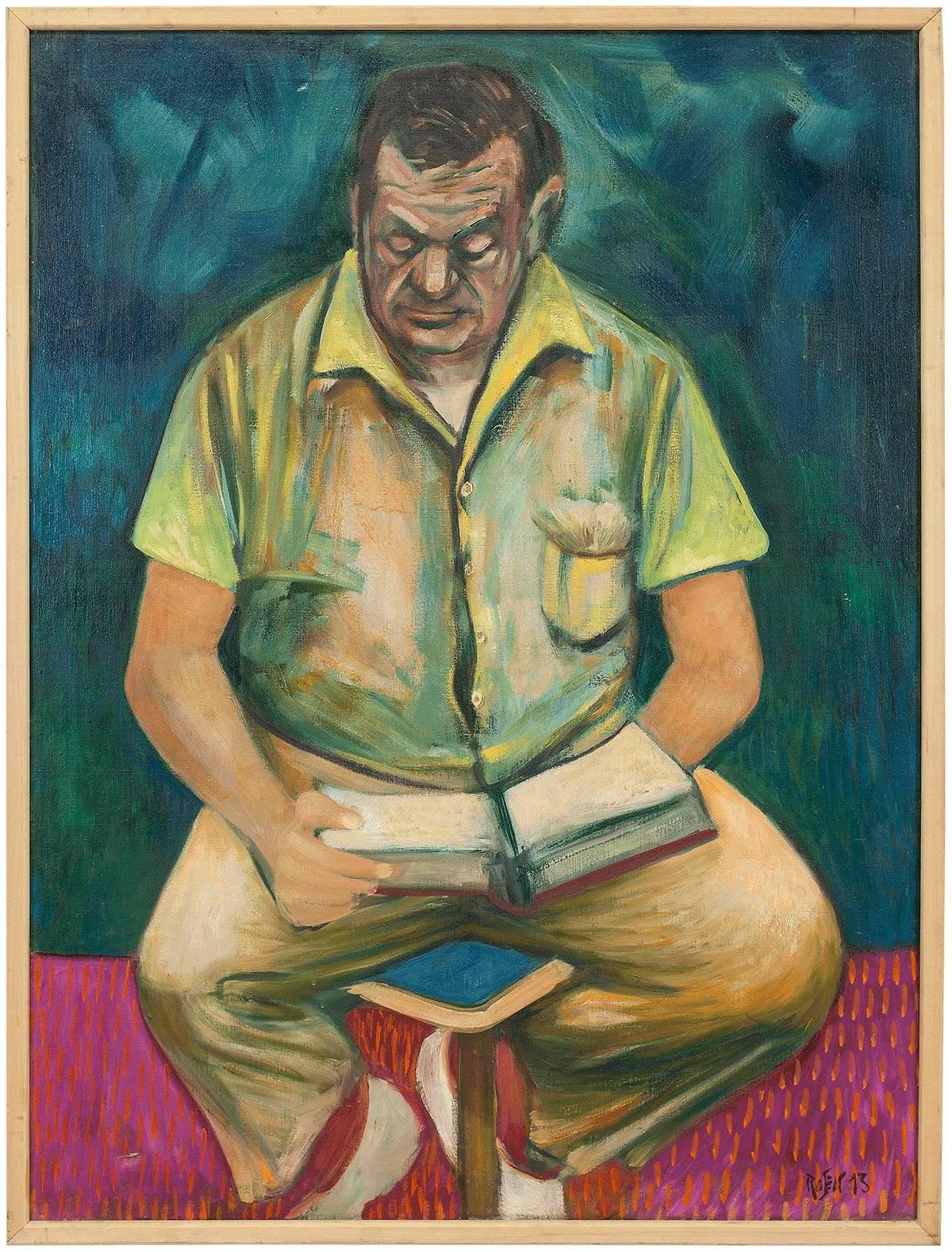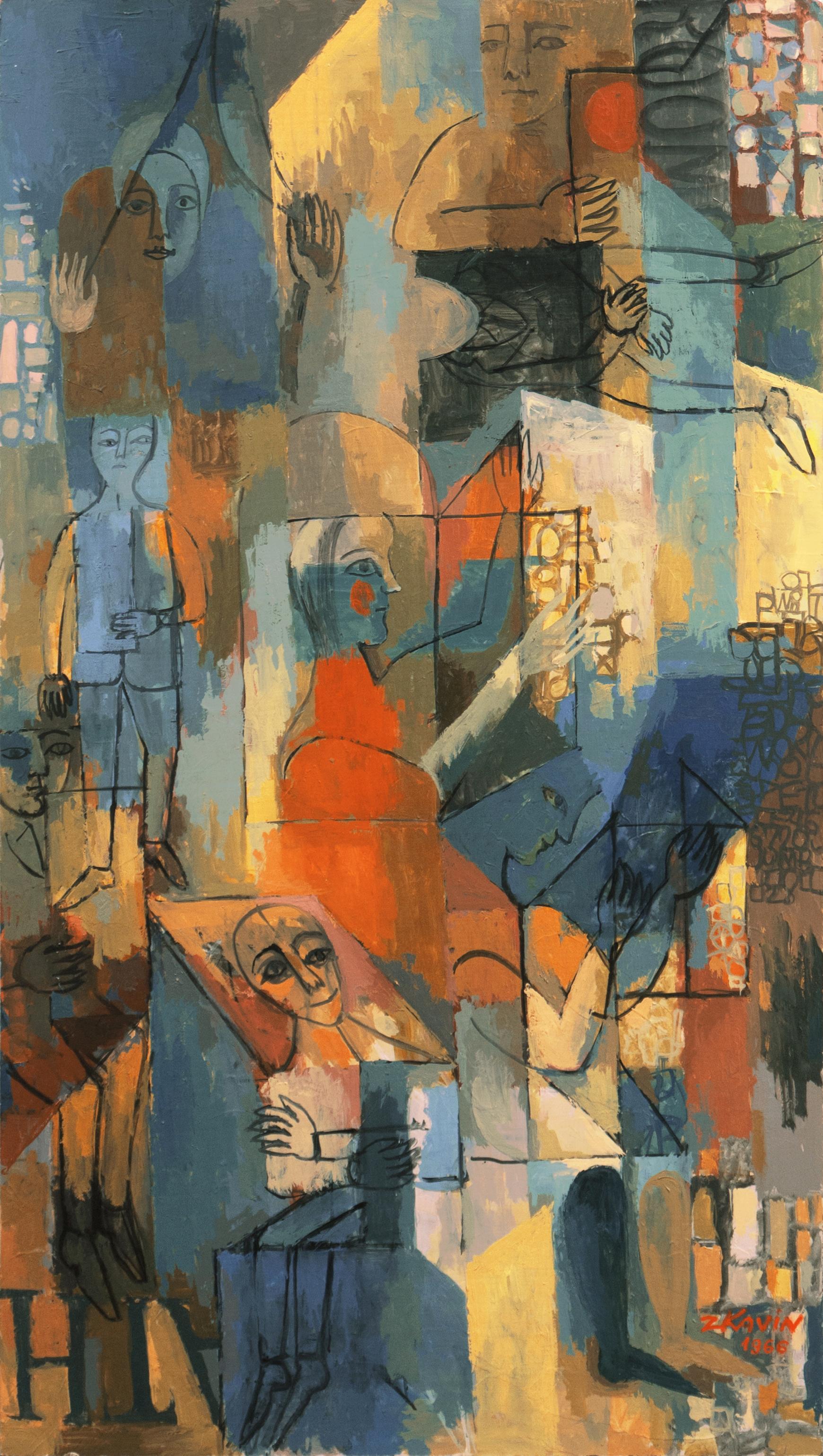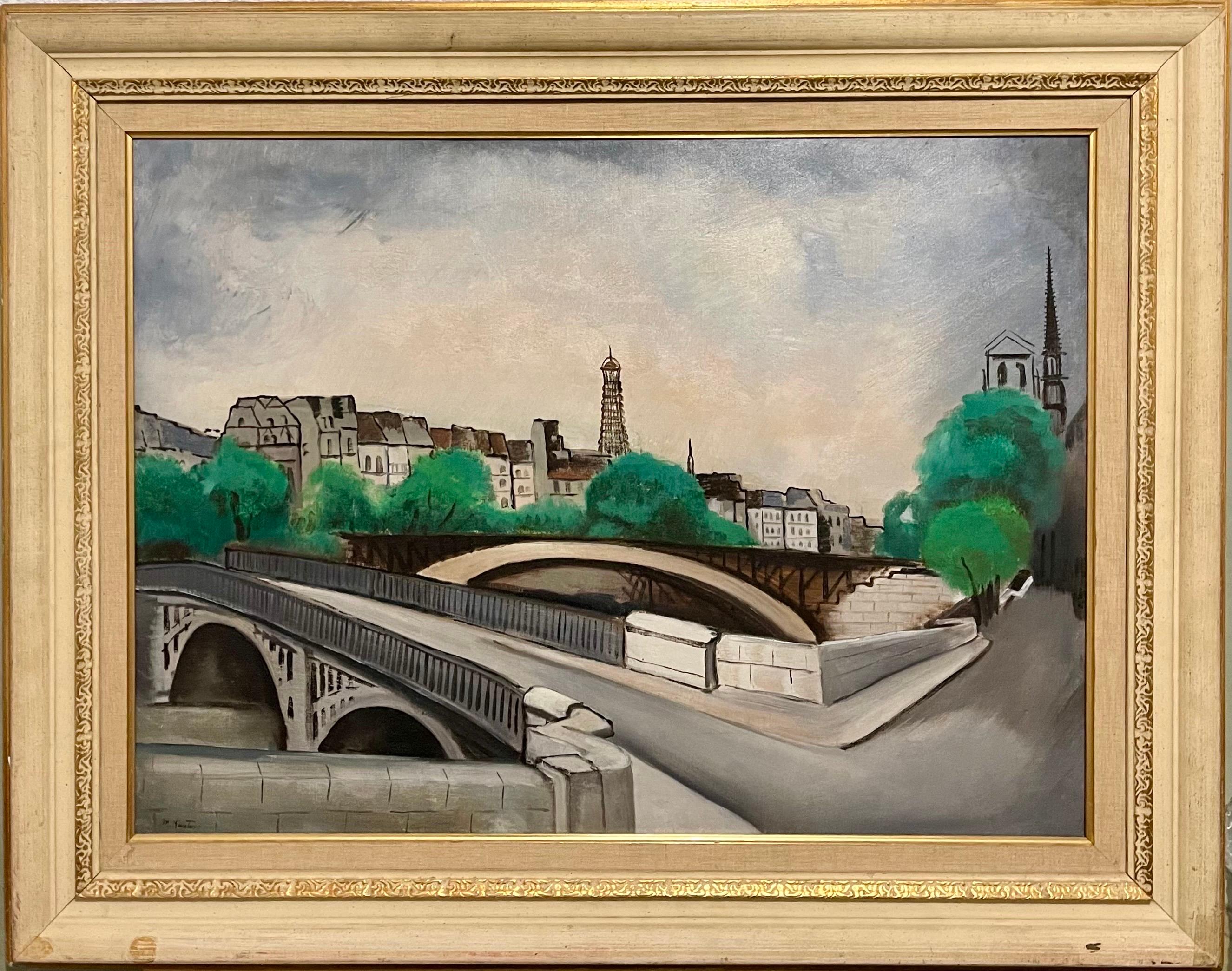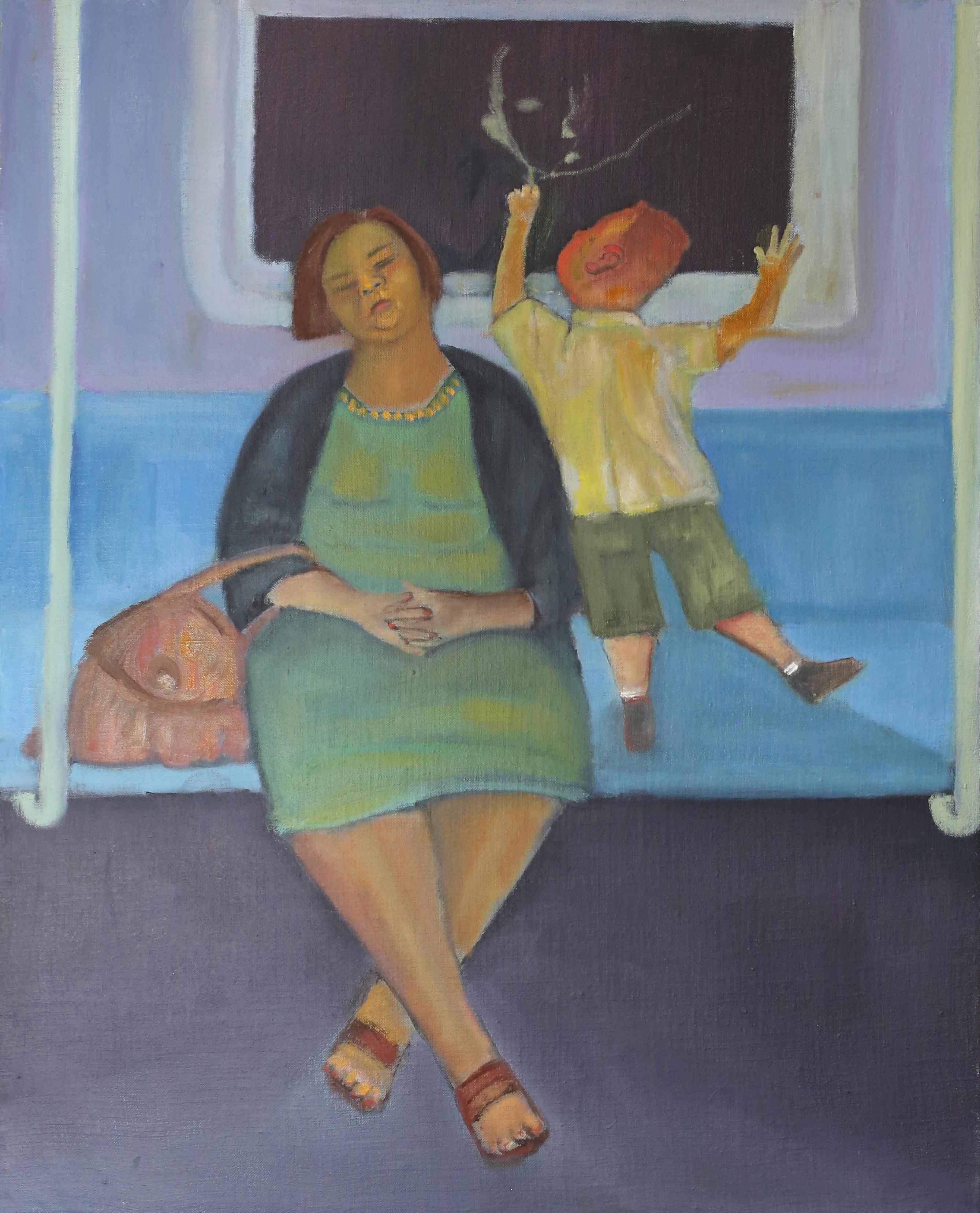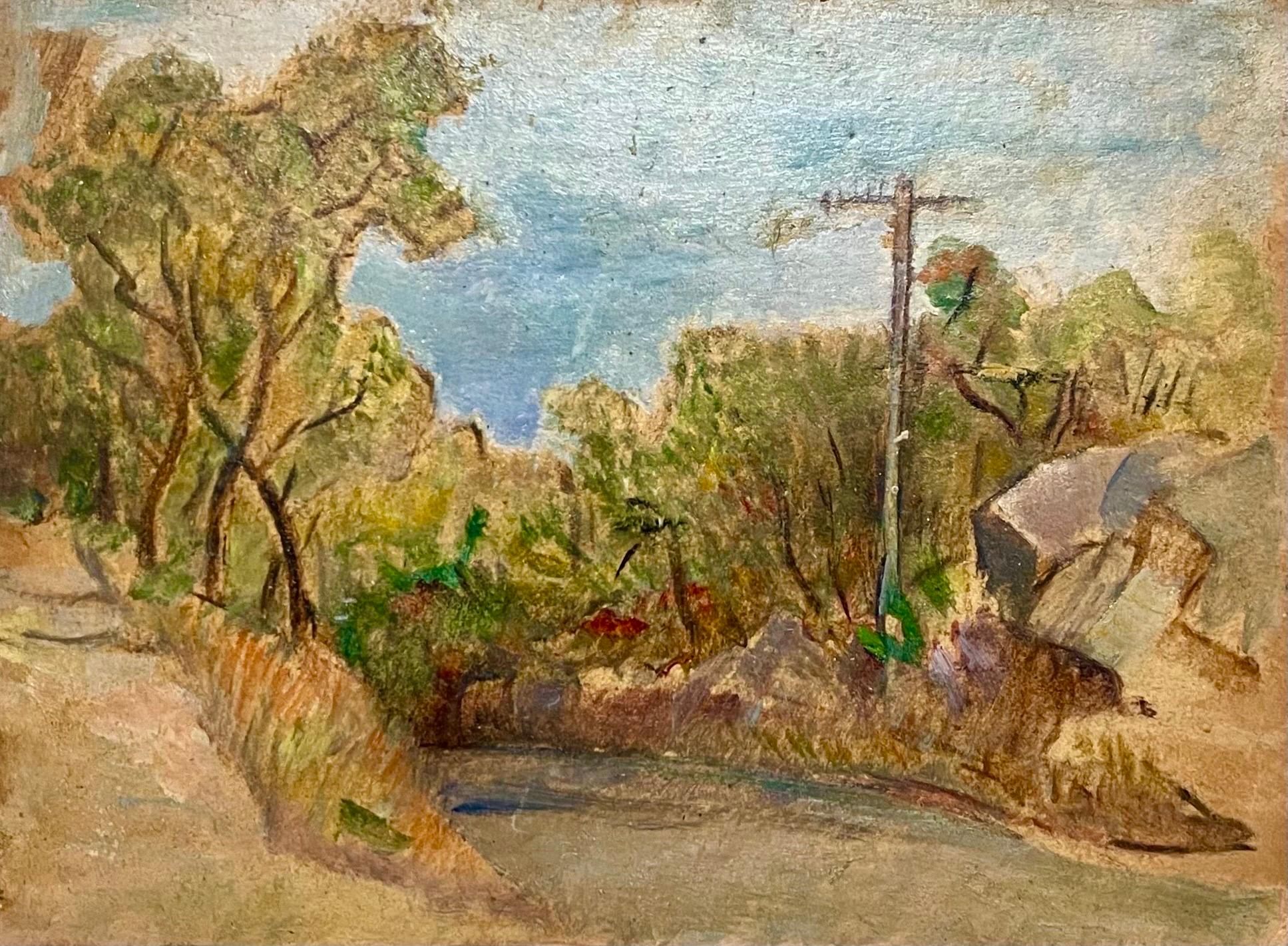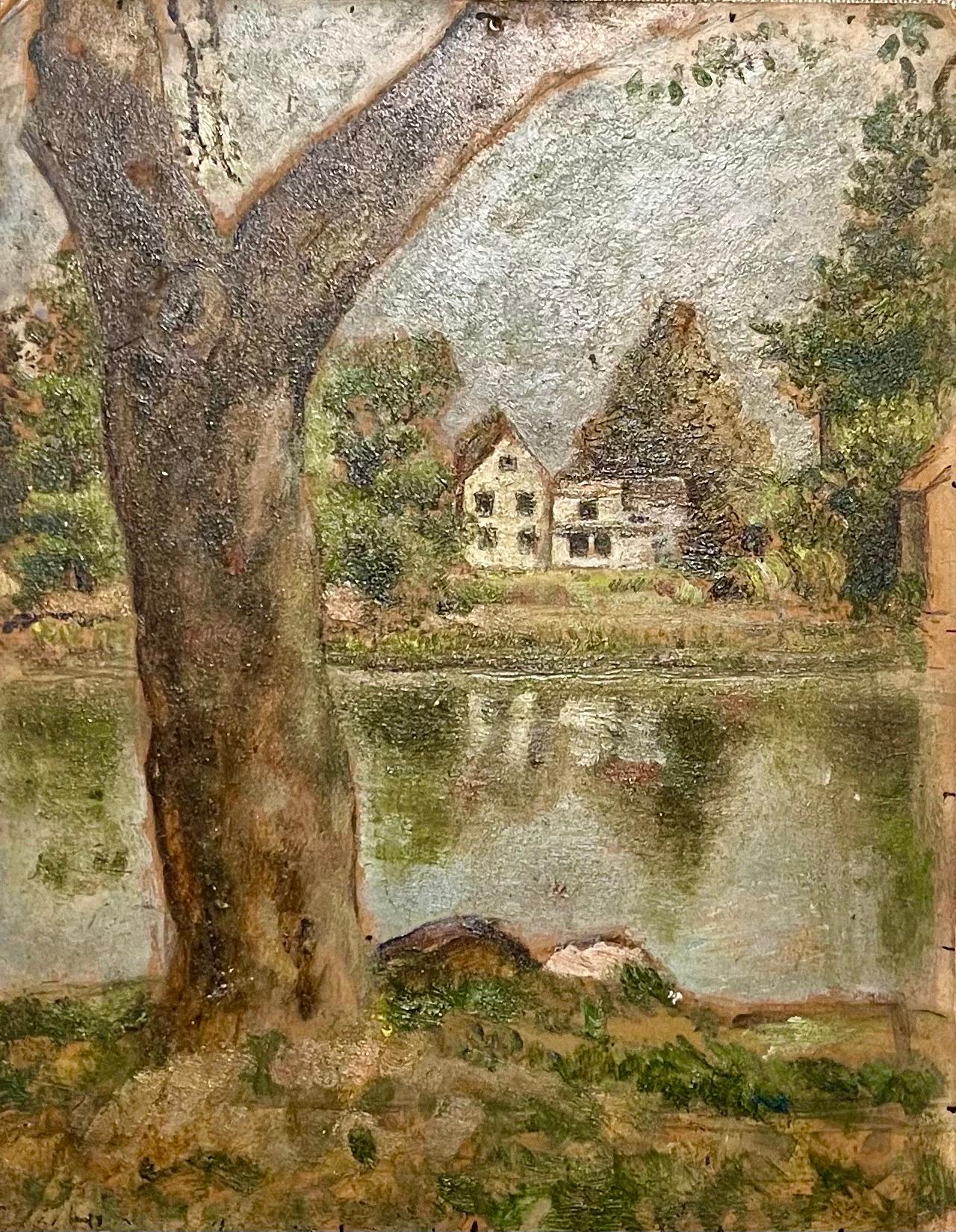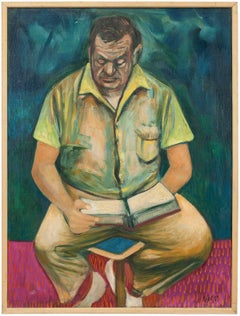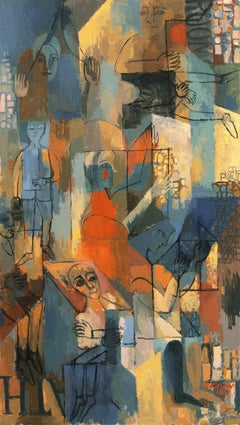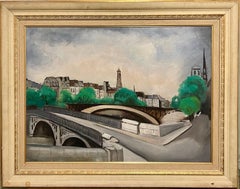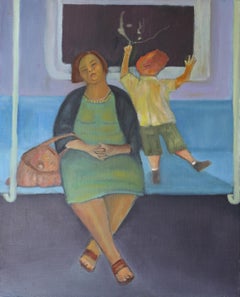Items Similar to Head, Woman 1-11
Want more images or videos?
Request additional images or videos from the seller
1 of 5
Robert JessupHead, Woman 1-11
About the Item
Born in Moscow, Idaho,and raised in Seattle, Robert Jessup received his BFA from the University of Washington in 1975 and his MFA from the University of Iowa in 1979. His work has been exhibited extensively since 1981 and is in numerous private and public collections including the metropolitan Museum of Art, the Brooklyn Museum, the University of Virginia, the University of Texas, the Anderson Museum of Contemporary Art, and the Dallas Museum of Art. He is a Professor Emeritus from the University of North Texas where he taught painting in the College of Visual Arts and Design from 1991 to 2018. His work is represented by the Conduit Gallery in Dallas, Texas.
In 2019, Jessup and his wife, Faith Scott Jessup, moved to Whidbey Island, Washington.
- Creator:Robert Jessup (1952, American)
- Dimensions:Height: 20 in (50.8 cm)Width: 20 in (50.8 cm)
- Medium:
- Movement & Style:
- Period:
- Condition:
- Gallery Location:Atlanta, GA
- Reference Number:1stDibs: LU155528748122
About the Seller
5.0
Vetted Professional Seller
Every seller passes strict standards for authenticity and reliability
Established in 2008
1stDibs seller since 2021
18 sales on 1stDibs
Typical response time: 1 to 2 days
- ShippingRetrieving quote...Shipping from: Atlanta, GA
- Return Policy
Authenticity Guarantee
In the unlikely event there’s an issue with an item’s authenticity, contact us within 1 year for a full refund. DetailsMoney-Back Guarantee
If your item is not as described, is damaged in transit, or does not arrive, contact us within 7 days for a full refund. Details24-Hour Cancellation
You have a 24-hour grace period in which to reconsider your purchase, with no questions asked.Vetted Professional Sellers
Our world-class sellers must adhere to strict standards for service and quality, maintaining the integrity of our listings.Price-Match Guarantee
If you find that a seller listed the same item for a lower price elsewhere, we’ll match it.Trusted Global Delivery
Our best-in-class carrier network provides specialized shipping options worldwide, including custom delivery.More From This Seller
View AllDe Una Casa a Otra
By Silvana ROBERT
Located in Atlanta, GA
Silvana Robert was born in 1965 in Argentina. She took first row between the artists of her generation. Well-educated at the National School of Fine Arts and having gone through work...
Category
21st Century and Contemporary Modern Figurative Paintings
Materials
Oil
La Cueva de Platon
Located in Atlanta, GA
I was born in Mexico City in 1963 and brought to the United States in the mid 70's, by my parents, when I was 13 years old. I attended my first art class in the late 80's, while at ...
Category
21st Century and Contemporary Modern Figurative Paintings
Materials
Oil
Creador
Located in Atlanta, GA
I was born in Mexico City in 1963 and brought to the United States in the mid 70's, by my parents, when I was 13 years old. I attended my first art class in the late 80's, while at ...
Category
21st Century and Contemporary Modern Figurative Paintings
Materials
Oil
Encontrarnos, 2006
Located in Atlanta, GA
I was born in Mexico City in 1963 and brought to the United States in the mid 70's, by my parents, when I was 13 years old. I attended my first art class in the late 80's, while at ...
Category
21st Century and Contemporary Modern Figurative Paintings
Materials
Oil
Orejas de Burro
Located in Atlanta, GA
Graduated from the Prilidiano Pueyrredón National School of Fine Arts. He also studied set design, was a student of Osvaldo Attila and Armando Sapia, among other artists.
He held so...
Category
21st Century and Contemporary Modern Figurative Paintings
Materials
Oil
Theeater of Life
Located in Atlanta, GA
Graduated from the Prilidiano Pueyrredón National School of Fine Arts. He also studied set design, was a student of Osvaldo Attila and Armando Sapia, among other artists.
He held so...
Category
21st Century and Contemporary Modern Figurative Paintings
Materials
Oil
You May Also Like
Middle Age Aint That Bad. (Retiree Reading a Book)
By David Rosen (b.1912)
Located in Surfside, FL
DAVID ROSEN
Toronto, Canada, b. 1912, d. 2004
Painter David Rosen emerged onto the art scene while the country was wrought with unimaginable economic turmoil. Like most other Americans, the Great Depression pummeled artists financially, leaving them destitute and unable to find even conventional labor work. However, in the midst of such devastation, the government implemented arts projects which strove to achieve employment for these artists. The program arose during a memorable era for art and funded the careers of several renowned artists, including Jackson Pollack, Arshile Gorky, and Lee Krasner before they found success. In 1936, Rosen himself joined the program and quickly accompanied his contemporaries in building the next movement of modern art, Abstract Expressionism.
Born in 1912, Rosen grew up in Toronto, Canada before pursuing arts in the United States. Upon arriving, Rosen settled in New York City and attended the Cooper Union Art school in 1930. While participating in the Federal Arts Project, he worked for the program's mural department until 1941. As well, he worked with an artist collective, Siqueiros Art Workshop. There, Rosen met fellow FAP artist Jackson Pollack, and together, with artist Phillip Guston, they experimented with new painting techniques and mediums. Art movements are often reactions to the popular styles that precede them, and Abstract Expressionism applied a new and exciting method to Modern Art. Gradually, artists began to break away from an overly-studied, academic approach to painting and liberated their technique. During these workshops, Rosen was introduced to Pollack's groundbreaking "drip painting" before it changed the art world.
As America became involved in World War II, the Federal Arts Project wound down, officially ending in 1942. Around this time, Rosen enlisted as a Merchant Seaman with the U.S Merchant Marines. During this time, he traveled to North Africa and Italy before concluding his service and moving to California where, in 1945, he devoted his full attention to building an art career. Within a couple of years, he landed a major exhibition at the Los Angeles County Museum of Art in 1947, and his first one-man show, which opened to rave reviews, was held at Hollywood's Contemporary Art Gallery. The exhibition’s success led to mural commissions from Palm Springs' Hotel del Tahquitz, and he scored more solo shows at West Hollywood's Chabot Gallery.
The early 1950s brought a surge of recognition for Rosen's career, and while his work was certainly still influenced by Abstract Expression, his painting style included elements of Surrealism, Figurative Art, and Cubism. Like his colleague Jackson Pollack, Rosen produced work inspired by drip painting; however, rather than splattering, his drips were the natural flow marks from painting freely without regard for "mistakes." Throughout Rosen's long career, he would acquire techniques from vastly different art styles which made for a varied, eclectic catalog of work.
Rosen continued to build his California art career and settled at a Laguna Beach art colony in 1958. There, he entered his work in the Laguna Beach Festival of Arts and was the first painter to contribute Abstract Art to the event. Rosen would participate in the festival for the next fifteen years. A year after his move, in 1959, Rosen opened his first studio gallery and began a 12-year collaboration with the Laguna Playhouse. For the next two decades, Rosen participated in 17 art exhibitions and 20 solo shows, and received considerable critical praise.
Rosen's themes were as varied as his evolving painting style, and one of his themes focused on classic characters like Shakespeare's Hamlet. Rosen's close-up portraits of historical and literary figures, illustrated by the piece To Be or Not to Be: Soliloquy From Hamlet, capture the essence of the characters while remaining loose with the painting and even adding a slight cartoon feel. His ongoing Hamlet series, as a complete collection, makes an impact with the diversity of technique. Unlike the loose style of some of his works, the painting Madaam... that he is mad is true is influenced by the structure of Cubism, the flat dimensions of Byzantine Art, and his utilization of mixed media.
After Rosen's death in 2004, the Laguna Beach Festival of Arts sponsored an exhibition of his Hamlet paintings at the Wells Fargo Building gallery. Throughout Rosen's career, he amassed a great deal of critical, industry, and public praise for his work. His beloved town of Laguna Beach bestowed numerous awards that include the Laguna Beach Annual Art Gallery Award and Orange County's Annual Exhibit Award. Rosen's work flourished in California, and he received recognition from the San Diego County Fair, Los Angeles' Miracle Mile...
Category
20th Century Modern Figurative Paintings
Materials
Canvas, Oil
'Modernist Figural', California, New Mexico, Oakland Museum, SFAA, SFMA, GGIE
Located in Santa Cruz, CA
Signed lower right, 'Z. Kavin' for Zena Kavin (American, 1912-2003) and dated 1966.
Born in Berkeley, California, Zena Kavin studied at the California School of Fine Arts in San Francisco and, privately, with Kravchenko in Moscow. She lived in Berkeley and in Oakland her entire life, except for four years spent in New Mexico in the late 1930s. In 1949, she married artist Jon Cornin and settled with him in Oakland. Under the peudonym Corka, the Cornins produced cartoons for the Saturday Evening Post and the New Yorker. Kavin worked in various media, including wood engraving, lithography and sculpture. She was a member of the San Francisco Artists Association and exhibited with them as well as at the San Francisco Museum of Art Inaugural (1935), the California–Pacific International Exposition, San Diego (1935), the Golden Gate International Exposition (1939). Her work is held in the permanent collections of the Davis Art Center, the New Mexico Museum of Art and the Oakland Museum of California.
Reference:
Artists in California 1786-1940, Third Edition, Edan Milton Hughes: Crocker Art Museum, Sheridan Books 2002, Vol. 1, page 610; Who Was Who in American Art 1564-1975: 400 Years of Artists in America, Peter Hastings Falk, Sound View Press 1999, Vol. 2, page 1801; Mallett’s Index of Artists, Supplement, Daniel Trowbridge Mallett, Peter Smith...
Category
1960s Modern Figurative Paintings
Materials
Masonite, Oil
1927 Oil Painting Eiffel Tower Paris American Modernist Wpa Artist Morris Kantor
By Morris Kantor
Located in Surfside, FL
Morris Kantor New York (1896 - 1974)
Paris from the Ile St. Louis, 1927 (view of Eiffel Tower)
Oil painting on canvas
Hand Signed lower left.
Provenance: Hirshhorn Museum and Sculpture Garden, Smithsonian Institution ( bears label verso)
Size: 20 3/4"H x 28 1/8"W (sight), 28.75 "H x 36"W (framed)
Morris Kantor (Belarusian: Морыс Кантор) (1896-1974) was a Russian Empire-born American painter based in the New York City area.
Born in Minsk on April 15, 1896, Kantor was brought to the United States in 1906 at age 10, in order to join his father who had previously relocated to the states. He made his home in West Nyack, New York for much of his life, and died there in 1974. He produced a prolific and diverse body of work, much of it in the form of paintings, which is distinguished by its stylistic variety over his long career. Perhaps his most widely recognized work is the iconic painting "Baseball At Night", which depicts an early night baseball game played under artificial electric light. Although he is best known for his paintings executed in a realistic manner, over the course of his life he also spent time working in styles such as Cubism and Futurism, and produced a number of abstract or non-figural works. A famous cubist, Futurist, painting of his "Orchestra" brought over 500,000$ at Christie's auction house in 2018
Kantor found employment in the Garment District upon his arrival in New York City, and was not able to begin formal art studies until 1916, when he began courses at the now-defunct Independent School of Art. He studied landscape painting with Homer Boss (1882-1956). In 1928, after returning to New York City from a year in Paris, Kantor developed a style in which he combined Realism with Fantasy, often taking the streets of New York as his subject matter. He did some moody Surrealist Nude paintings and fantasy scenes. In the 1940's he turned towards figural studies. Later in his career, Kantor himself was an instructor at the Cooper Union and also at the Art Students League of New York in the 1940s, and taught many pupils who later became famous artists in their own right, such as Knox Martin, Robert Rauschenberg, Sigmund Abeles and Susan Weil...
Category
1920s American Modern Landscape Paintings
Materials
Canvas, Oil
The Budding Artist urban narrative muted blue colors subway scene
By Stephen Basso
Located in Brooklyn, NY
Oil on linen mounted on board signed and dated on reverse.
Category
2010s American Modern Figurative Paintings
Materials
Linen, Board, Oil
Simka Simkhovitch WPA Artist Oil Painting Gouache American Modernist Powerline
By Simka Simkhovitch
Located in Surfside, FL
Simka Simkhovitch (Russian/American 1893 - 1949)
This came with a small grouping from the artist's family, some were hand signed some were not.
These were studies for larger paintings.
Simka Simkhovitch (Симха Файбусович Симхович) (aka Simka Faibusovich Simkhovich) (Novozybkov, Russia May 21, 1885 O.S./June 2, 1885 N.S.—Greenwich, Connecticut February 25, 1949) was a Ukrainian-Russian Jewish artist and immigrant to the United States. He painted theater scenery in his early career and then had several showings in galleries in New York City. Winning Works Progress Administration (WPA) commissions in the 1930s, he completed murals for the post offices in Jackson, Mississippi and Beaufort, North Carolina. His works are in the permanent collections of the Dallas Museum of Art, the National Museum of American Art and the Whitney Museum of American Art. Born outside Kyiv (Petrograd Ukraine) into a Jewish family who owned a small department store. During a severe case of measles when he was seven, Simcha Simchovitch sketched the views outside his window and decided to become an artist, over his father's objections. Beginning in 1905, he studied at the Grekov Odessa Art School and upon completion of his studies in 1911 received a recommendation to be admitted to the Imperial Academy of Arts. Though he enrolled to begin classes in architecture, painting, and sculpture at the Imperial Academy, he was dropped from the school roster in December because of the quota on the number of Jewish students and drafted into the army. Simchovitch served as a private in the 175th Infantry Regiment Baturyn [ru] until his demobilization in 1912. Re-enrolling in the Imperial Academy, he audited classes.
Simka Simkhovitch exhibited paintings and sculptures in 1918 as part of an exhibition of Jewish artists and in 1919 placed 1st in the competition "The Great Russian Revolution" with a painting called "Russian Revolution" which was hung in the State Museum of Revolution. In 1922, Simkha Simkhovitch exhibited at the International Book Fair in Florence (Italian: Fiera Internazionale del Libro di Firenze). In 1924, Simkhovitch came to the United States to make illustrations for Soviet textbooks and decided to immigrate instead. Initially he supported himself by doing commercial art and a few portrait commissions. In 1927, he was hired to paint a screen for a scene in the play "The Command to Love" by Fritz Gottwald and Rudolph Lothar which was playing at the Longacre Theatre on Broadway. Art dealers began clamoring for the screen and Simkhovitch began a career as a screen painter for the theater. Catching the attention of the screenwriter, Ernest Pascal, he worked as an illustrator for Pascal, who then introduced him to gallery owner, Marie Sterner. Simkhovitch's works appeared at the Marie Sterner Gallery beginning with a 1927 exhibit and were repeated the following year. Simkhovitch had an exhibit in 1929 at Sterner's on circus paintings. In 1931, he held a showing of works at the Helen Hackett Gallery, in New York City and later that same year he was one of the featured artists of a special exhibit in San Francisco at the California Palace of the Legion of Honor in Lincoln Park. The exhibit was coordinated by Marie Sterner and included four watercolors, including one titled "Nudes". He is of the generation of Russian Soviet artists such as Isaac Pailes, Serge Charchoune, Marc Chagall, Chana Orloff, Isaac Ilyich Levitan, and Ossip Zadkine.
In 1936, Simkhovitch was selected to complete the mural for the WPA Post office project in Jackson, Mississippi. The mural was hung in the post office and courthouse in 1938 depicted a plantation theme. Painted on the wall behind the judge’s bench, “Pursuits of Life in Mississippi”, a depiction of black workers engaged in manual labor amid scenes of white professionals and socialites, was eventually covered over in later years during renovations due to its stereotypical African American imagery. Simka painted what he thought was typical of Jackson. His impression of pre-civil rights Mississippi was evidently Greek Revival column houses, weeping willow trees, working class families, and the oppression of African Americans. He painted African American men picking cotton, while a white man took account of the harvest and a white judge advised a white family, calling it Pursuits of Life in Mississippi.
Though clearly endorsed by the government and initially generally well-received, the mural soon raised concerns with locals as the climate toward racial segregation began to change. The main concern was whether depictions that show African Americans in subjugated societal roles should be featured in a courtroom. The following year, his painting "Holiday" won praise at an exhibition in Lincoln, Nebraska. In 1940, Simkhovitch's second WPA post office project was completed when four murals, "The Cape Lookout Lighthouse and the Orville W. Mail Boat", "The Wreck of the Crissie Wright", "Sand Ponies" and "Canada Geese" were installed in Beaufort, North Carolina. The works were commissioned in 1938 and did not generate the controversy that the Jackson mural had. The main mural is "The Wreck of the Crissie Wright" and depicts a shipwreck which had occurred in Beaufort in 1866. "The Cape Lookout Lighthouse and the Orville W. Mail Boat" depicted the lighthouse built in 1859 and the mail boat that was running mail during the time which Simkhovitch was there. The boat ran mail for the area until 1957. "Sand Ponies" shows the wild horses common to the North Carolina barrier islands and "Canada Geese" showed the importance of hunting and fishing in the area. All four murals were restored in the 1990s by Elisabeth Speight, daughter of two other WPA muralists, Francis Speight...
Category
1930s American Modern Landscape Paintings
Materials
Oil, Board, Gouache
Simka Simkhovitch WPA Artist Oil Painting American Modernist Landscape Pond Tree
By Simka Simkhovitch
Located in Surfside, FL
Simka Simkhovitch (Russian/American 1893 - 1949)
This came with a small grouping from the artist's family, some were hand signed some were not.
Thes...
Category
1930s American Modern Landscape Paintings
Materials
Oil, Board
